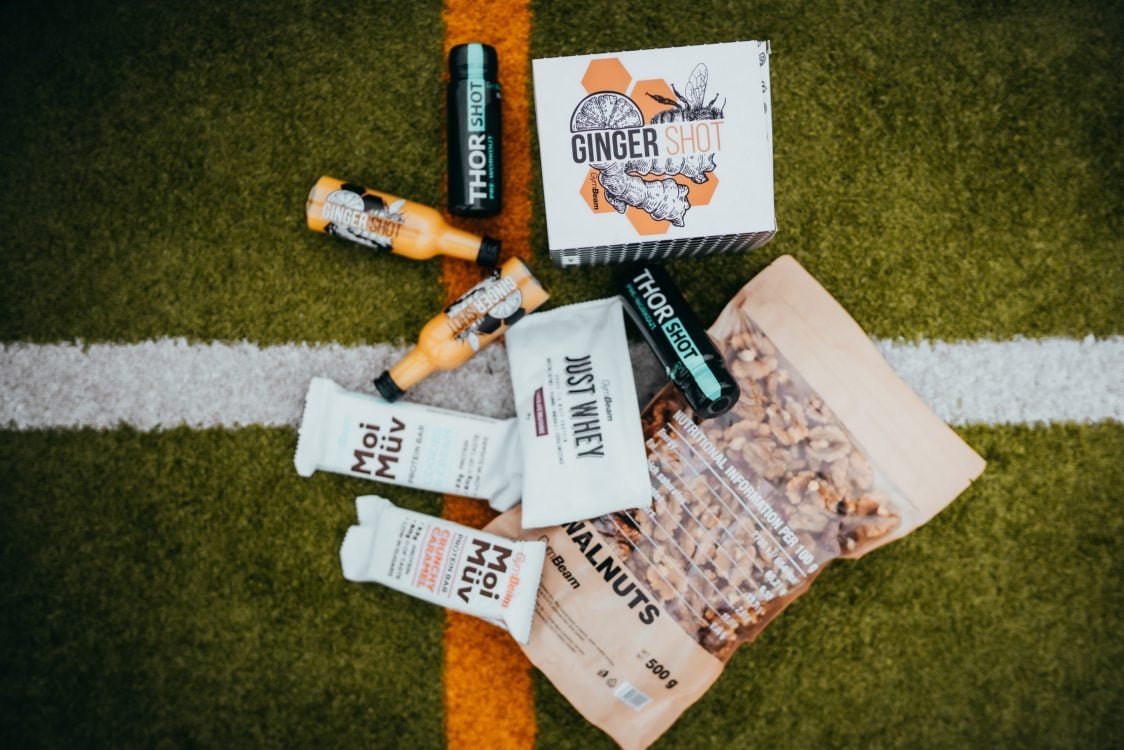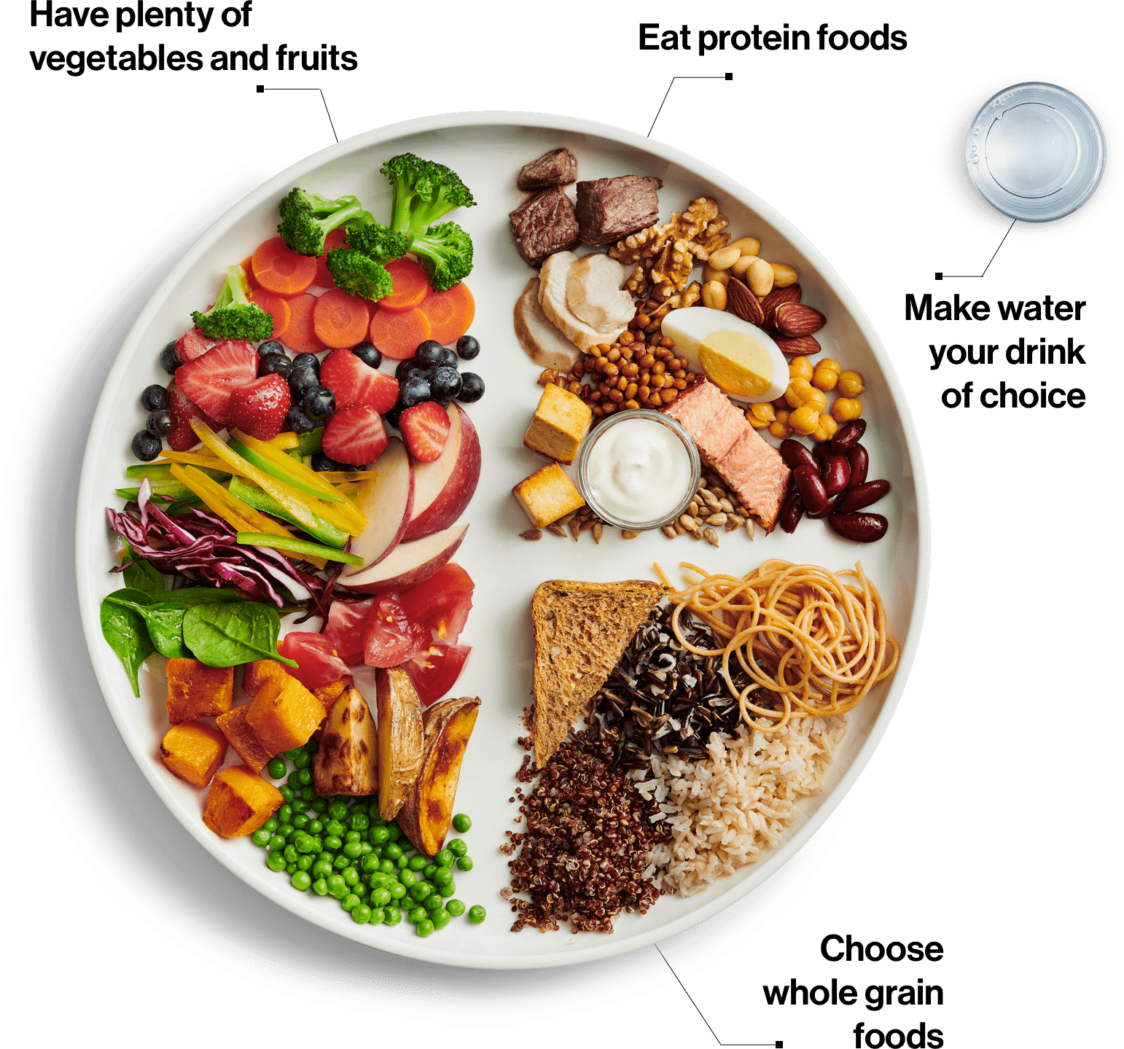Table of Contents
People are increasingly aware of the importance of healthy eating, which should be a fixed part of all of our daily lives. But what does healthy eating really mean? Don’t worry, it’s not just steamed broccoli with cooked chicken or lettuce with salad three times a day, as it might seem at first glance. You don’t even have to run straight to the bookshop for the latest breakthrough book on healthy eating and start eliminating pastries, dairy products, or avoiding gluten like the devil. You may even be surprised at what a healthy diet can look like.
Unfortunately, there are still a lot of unnecessary myths and beliefs about healthy diet, which make the issue of eating much more complex than it needs to be. Think for yourself about what you have heard about healthy eating. One day, gluten, then fat, or sugar are blamed for global obesity, and from the documentaries on Netflix, it may seem that we should all become vegans. Due to such an information jungle, it is not surprising that people often fail, or prefer not to start, in their attempts to eat healthier foods because they resent the idea that they would have to eat only a certain type of food, for example. But it’s all so much simpler, it’s just us making things unnecessarily difficult for ourselves.
Why should you eat healthy?

The link between nutrition and human health has been scrutinized today by countless scientific studies, human history, or the very observation of one’s own life over time. Optimal nutrition is one of the reasons why, on average, the populations of so-called blue zones live to the highest age. [1]
What can healthier eating bring you?
- A healthy diet can greatly reduce the risk of developing the world’s biggest killers in the form of cardiovascular disease and cancer. [2-4]
- Better quality of life. Healthier eating habits are generally associated with lower body weight, which means less likelihood of developing type 2 diabetes or joint problems. [5-6]
- Improving, or at least maintaining, brain function including memory and good mood. Diet generally affects the feeling of fatigue and how we feel. Improving your diet is such a good way to recharge your batteries and smile more. [7–9]
- Healthier digestion thanks to optimal intake of fiber, prebiotics and probiotics. [10-11]
- Better athletic performance and body composition. Sufficient intake of all essential nutrients will boost your performance in any sport and improve your body composition in favour of muscle mass and fatty tissue loss. [12-13]
As you can see, a healthy diet and healthier eating habits can bring you many benefits. The most important thing is to promote overall health, of which we all have only one, and we often start taking care of it when a health problems begin to occur, which is too late. It is better to prevent problems than to “extinguish” them.
How can one define healthy eating?
According to the Cambridge University dictionary, healthy food is one that is believed to be good for human health because it does not contain artificial chemicals or too much sugar or fat. If you studied what the WHO says about healthy eating, you would find some numerical expressions of what a healthy diet should (not) look like. But let’s not complicate things unnecessarily for now and look at how we can define healthy eating in a much simpler and more concise way. [14]
You might be interested in these products:
Healthy diet:
1. Controls energy intake
The laws of physics apply to each of us, which is why the key to losing or gaining weight. It is still the old known energy intake vs. expenditure. The body works best when it has enough energy without which some of the body’s functions, such as immune or reproductive functions, would be suppressed. On the other hand, excessive energy intake leads to weight gain and increased fat reserves. [15-16]
If you are interested in calculating your energy intake relative to your needs, read our article How to Calculate Your Energy and Macronutrient Intake for Weight Loss or Muscle Gain?

2. Provides optimal nutrient amounts
Food is not just ordinary fuel. It contains a range of vitamins, minerals and biologically active substances that perform a number of important tasks in the body. Magnesium is involved in over 300 biochemical reactions that could not have happened without it. Each food has a certain nutritional density, i.e. the energy and micronutrient content per unit of weight. And because a healthy diet is supposed to provide optimum amounts of energy and micronutrients, you need to know how much and what food is appropriate for your needs to eat.
- Does 100 grams of cookies or 100 grams of berry fruit have more calories? That’s right, cookies have about 430 kcal more, and they have a high energy density, but low nutritional density because they don’t contain many micronutrients.
- Which has more micronutrients, 100 grams of biscuits or 100 grams of berry fruit? As you may already suspect, berry fruit, wins out as they contain more micronutrients, including strong antioxidants, and thus have a low energy density but a high nutritional density.
Everyone needs energy and micronutrients in their diet. You just need to think a little bit about the nutritional and energy value of food and choose accordingly. That doesn’t mean you can’t have something sweet in your life. In case you are wondering how to indulge in sweets without regrets, read our article 7 Tips on How to Snack and Not Gain Weight.

3. Helps you to look and feel better
Thanks to the fact that a healthy diet can control energy intake without having to count calories, it has a huge impact on our appearance, self-esteem and how we feel.
When you learn a few basic principles of healthy eating and see how your body reacts to it, you are able to make small changes in your diet that will lead you to your dream body. If you want to lose weight, it may be enough to start by focusing on consuming enough protein, vegetables, fruits and less highly industrially processed foods.
Healthy eating habits are supposed to help you feel comfortable in your body and live a healthy and fulfilling life, nothing less, nothing more. In case you want to learn more about how to lose weight without counting calories, read our article Calorie Deficit: How to Lose Weight and Have a Life?
4. Promotes athletic performance
If you are interested in a healthy diet and an active lifestyle, you are probably also engaged in some type of sporting activity or, on the contrary, you are thinking about how to promote athletic performance with your diet. Even with this, a healthy diet helps by controlling energy intake and providing valuable micronutrients, which athletes in particular often need at an increased rate. Sprinters or team athletes will thus need a slightly higher carbohydrate intake, while bodybuilders and fitness athletes will benefit from a higher protein intake.
5. It is results based
Your past eating habits have led you to some result, and perhaps with this result in the form of how you feel or look, you are not entirely satisfied and want to change it. You may be convinced you’re eating healthy, but you still don’t feel comfortable in your body.
Since a healthy diet controls energy intake, provides optimal amounts of micronutrients, and helps you feel and look better, it is possible that you are not eating as healthily as you think. What exactly is a healthy diet for you? When you start considering the results of your nutritional choices and eating habits, it can make it a lot easier for you to make better decisions in the future. When trying to change body composition, it is not enough to monitor weight, but it is much better to monitor other parameters in the form of body measurements. If you want to learn why weight is not a reliable indicator of progress, read our article Why the Scale Shows You a Higher Number, and It Is Not Fat.

6. Promotes physical and mental health
Healthier eating habits usually means a lower body weight, more energy and less fatigue during the day. A healthy body weight also means reducing the risk of developing a number of civilizational diseases. Diet also affects how we feel. It even turns out that foods rich in probiotics can also have a positive effect on mental health. [7–9] [17–20]
The Wim Hof method or hardening itself can help you build a stronger immunity and support for your physical and psychological health. If you are interested, read our article How to Get Stronger Immunity Thanks to Cold Water Therapy?
7. Reduces the risks of civilizational diseases
A healthy diet provides plenty of healthy nutrients as well as other substances that are protective in nature and help prevent disease. This is particularly true of fibre and its positive effect on reducing the risk of certain cancer, in particular colon cancer.
Furthermore, a healthy diet may help to reduce the risk of cardiovascular disease or insulin resistance and type 2 diabetes. By simply improving your diet, it is truly possible to positively affect your current and future health. [2-4] [21-22]
8. It is sustainable for you and the planet in the long term
Can you imagine eating the same in a year, two, five or even ten years? A healthy diet must be sustainable for you and our planet in the long run because we have only one planet. The number of people for whom subsistence needs to be provided is constantly increasing in the context of a growing population, but agricultural capacity is depleted. This is why we need to think a little more about food and not waste it.
At the intersection of a long term sustainable diet for us and the planet lie groups of foods that can help and are part of any balanced diet. Such foods include, for example, local and seasonal fruits, vegetables, potatoes, cereals or legumes.

How to learn to eat healthily?
As you can see, diet has a huge impact on all aspects of our lives, and when you add exercise to a healthy diet, you literally start to work miracles. At the same time, it is not difficult at all, so just begin gradually and without extreme approach. It is because they usually promise the impossible in no more than two days, but it is impossible. According to the WHO, an unhealthy diet, together with a lack of exercise, is the greatest global risk to human health. Even the latest nutritional recommendations for US citizens for the period 2020-2025, together with WHO recommendations, the EU and many other countries agree on several crucial nutritional factors. [14] [23-24]
Which foods and drinks should you cut down on to be healthier?
Using the example of the average person whose daily intake is 2,000 kcal, we will show how many grams of individual nutritional components one should receive in a day.
- Saturated fatty acids (fats). They should account for a maximum of 10% of total energy intake. They are found mainly in animal products such as sausages, butter, lard, fatty dairy products. But they are also found in plant sources in the form of coconut fat. Maximum intake = 22 g
- Trans unsaturated fats. These should account for a maximum of 1% of total energy intake. These are fats that are generally manufactured industrially and their main source is partially solidified fats, which can be easily identified by reading product labels. Their source is mainly different types of sweets. Maximum intake = 2.2 g
- Added sugars. According to the recommendation, added sugars should make up a maximum of 10% of total energy intake, and the WHO is considering decreasing this limit to 5% for additional health benefits. Maximum intake = 50g and after tightening the limit it is 25g. Most of the added sugars are hidden in various sweetened sodas, dairy products or pastries. If you want to learn more about added sugars and liquid calories, read our article Where Are Liquid Calories Hiding and How These Empty Calories Prevent You from Losing Weight?
- Salt. Salt intake should be less than 5 grams per day. This amount corresponds to approximately 2 grams of sodium. Foods with a relatively high salt content include sausages, cheeses, pastries, fast food, chips, sticks and all salty snacks. Reducing salt intake helps to prevent high blood pressure and other cardiovascular diseases.
- Alcohol. It would be ideal not to drink alcohol, of course, but limiting its consumption to about one beer or one glass of wine per day is beneficial. Remember that abstinence during the week and the subsequent “catch-up” at the weekend certainly do not apply. Excessive alcohol intake has been associated with a greater risk of developing civilizational diseases, including cancer and cardiovascular diseases. [25-26]

What foods contain the most salt, sugar, fat and we should eat them as little as possible?
Most nutritional guidelines and recommendations have one common feature. They advise against highly industrialized food. They contain little micronutrients in small quantities, but a lot of energy. Furthermore, they have such a high energy density and low nutritional density. But we want food to be the exact opposite. Our main goal should be to provide the body with all the necessary micronutrients and a “reasonable” amount of energy.
Why? The food industry processes the raw materials to the point of depriving them of the vast majority of beneficial substances such as fibre, while adding a number of food additives. It wants such foods to have a long shelf life, low production costs and at the same time people should like it. Thus, in the modern world, we have countless foods available almost 24/7 that typically contain large amounts of salt, sugar, fats or a combination of them. This makes it easier to overeat such foods, which thus stimulates the reward centre in the brain, and makes us feel “happy” for a while after consuming them. [27-28]
In the United States and across the advanced modern world, these foods are beginning to account for a majority share of energy intake. Which, unfortunately, is wrong. Such food is cheaper, but people will pay in the future in the form of poor health. Whether it’s an increasing in weight or increasing the risk of a number of civilizational diseases, isn’t it better to pay a little extra for a better diet and a healthier life? [29-31]

A healthy diet is not complicated. Start eating healthier today

The solution is basically very simple. For starters, all you have to do is take more care of what you eat and think about whether this love affair with partially congealed fat, dry salami or fries with mayonnaise is really the way to eat better?
Then all you have to do is cut the vast majority of highly industrially processed food from your diet and replace it with as much fresh and minimally processed food as possible.
What to imagine underneath it all?
- Highly industrialized foods: Sweetened breakfast cereals, sweet and white pastries, biscuits, sweets, chocolates, sweet and fatty dairy products, sweetened drinks, sausages, fried foods, chips, bars and a variety of other salty and sweet snacks.
- Minimally processed foods: Fruit, vegetables, meat, fish, whole grain cereals, potatoes, sweet potatoes, legumes, nuts, eggs, oats, unsweetened coffee, tea and water.
It’s really as simple as it looks. Basically, you could say that you just have to eat fresh food and cut down on industrialized foods. Even once in a while, you can indulge in whatever you want and not have to worry about never having a pizza or hamburger again in your life. A healthy diet is not about banning specific food groups. Just learn the simple basic rules, and sometimes you can have chocolate or ice cream just fine. If you wonder how to do it, read our article How to Eat Pizza, Sweets, and Still Lose Weight Thanks to IIFYM?
Create each meal according to the rules of a healthy diet
By following the principles of a healthy diet, you can easily manipulate the resulting energy value of each meal according to your goals.
- Dedicate 1⁄2 plates to the most colourful vegetables and fruit. Why? You will contribute to an optimal intake of a range of micronutrients, phytonutrients, fibre, and if you reach for fermented vegetables, you will also get a valuable dose of probiotics and prebiotics for healthy digestion. Remember, every person should consume at least 400 grams of vegetables and 200 grams of fruit per day.
- Dedicate 1⁄4 plate to protein. Why? Each meal should have a portion of protein roughly the size of your palm. Protein is essential for muscle growth and maintenance, optimal function of the immune system, it also promotes satiety and effectively fights sweet cravings. Prefer more dietary types of meat and do not stick with just one source of protein for all meals.
- Dedicate 1⁄4 plate to carbohydrates. Why? The days when most people worked manual labour for a living are almost over. Due to changing lifestyles and lower energy output, the composition of the diet also needs to be changed. In general, we don’t need as many carbohydrates as we once did, and a good stepping stone is to start with just a 1⁄4 plate and gradually see if you need to add or cut down on it based on your lifestyle. Choose from high-quality complex carbohydrates that generally contain more nutrients and fibre than refined versions.
- Fats. These are already a natural part of most sources of animal protein, therefore there is no need to pay extra attention here.
- Start a drinking regimen with water, unsweetened coffee and tea. This will guarantee you zero energy intake from drinks and often a huge reduction in sugar consumption.
- In case you want to learn more specific tips on how to start exercising and eating healthy, read our article 15 Tips on How to Lose Weight, Start Exercising and Eat Healthy.

What are the best sources of protein, fats and carbohydrates?
- Protein sources: meat, fish, seafood, milk, dairy products and cheeses, eggs, legumes (peas, beans, all kinds of lentils, chickpeas, edamame), pseudo-cereals (buckwheat, amaranth, quinoa), tofu, tempeh, nuts and seeds, vegetable meat substitutes, nutritional yeast, whey protein, plant-based protein, protein bars.
- Sources of fat: nuts and seeds, oils, olives, avocado, butter as a natural part of animal proteins.
- Carbohydrate sources: whole grains and cereals (oats, flour, rice, pasta, bread and pastries), pseudo-cereals, potatoes and sweet potatoes, legumes, fruits and vegetables.
What could a healthy plate of food look like?
- 1⁄4 plate of American potatoes, 1⁄4 plate grilled trout, 1⁄2 plate vegetable rainbow made from popular vegetables and a good dressing with a drop of olive oil.
- 0% Greek yogurt with 1 tablespoon oats, chia seeds and a piece of your favourite fruit
- A piece of quality whole-wheat pastry (baguette, kaiser roll or 2 smaller slices of bread) with two slices of ham, Edam cheese and a hard-boiled egg with your favourite vegetables and 2 pieces of medium-sized carrot.
What to do if you want to lose weight?

During the day, eat as many meals as you like while trying to live closer to the rules of a healthy diet. Avoid meals outside your plan, especially unconscious snacking and nibbling, you’d be surprised how much energy can be consumed unnecessarily.
The energy in a small spoonful of peanut butter just to taste, a piece of chocolate, a small pastry with spread or coffee with sweet syrup adds up during the day and can make several hundred calories, sabotaging your efforts to lose weight. This gives you far more effective control over your energy intake without having to count calories.
Once you have mastered these rules, for example, have some check time after your Sunday morning toilet visit, where you will consider, measure your basic body measurements and record the values in your diary or in a table where you will monitor your progress. Depending on these results, you will be better able to respond to changes and find out when to add or subtract food.
In two weeks on Sunday, weigh yourself again and take your body measurements under the same conditions. If you have not made progress, you need to either move more, reduce energy intake, or combine these two approaches. Simply reduce your carbohydrate portion for about two meals a day, and in another two weeks you will see how this change has been reflected in the parameters studied.
And if you want to get a better overview of energy intake and calories, read our article A Simple Guide on How To Count Calories and Achieve Your Goals.
What to do if you want to gain muscle?
Muscle growth requires a training impulse, a diet with a moderate energy surplus and optimal amounts of protein. Simply observe yourself again as above, and if your body measurements and weight do not begin to increase, increase your carbohydrate intake and make sure you are eating enough protein, which should fall roughly within the range of 1.4-2 grams of protein per kilogram of body weight. A high-quality whey or vegan vegetable protein can help with sufficient protein intake. [32]
And if you want to learn more about gaining muscle, read our article What to Eat and How to Exercise to Finally Gain Muscle?

What is definitely not a healthy diet?
- A healthy diet isn’t about all or nothing perfectionism and approach. It’s about long-term work. It doesn’t matter what you do once in a while, it matters what you do every day. Furthermore, it’s about learning to do your best with what you can do right now and the things you have at your disposal.
- A healthy diet is not about endless calorie counting and cutting down on foods. It’s about paying attention and noticing what you eat and how you eat. It’s about listening to your body’s signals and eating when hunger starts, and stopping when you’re feeling pleasantly satiated and not overfed. Likewise, it’s about learning to make healthier and smarter choices about food.
- A healthy diet isn’t easy, at first. In particular, newcomers who want to improve their diet may find it very challenging at first. But that’s with all that’s new in life. Once you have mastered the simple basics and learned to integrate everything into everyday life, everything will be much easier for you and soon a healthy diet will become automatic.
- Healthy diets are not about complicated rules and eliminating entire food groups. It’s about following basic and simple principles and using common sense. Extremes aren’t good in politics or nutrition. Of course, if someone has dietary restrictions for medical reasons, then gluten-free, lactose-free or any prescribed diet is in order.
- A healthy diet does not mean endless food preparation every day. No one wants to spend too much time in the kitchen, so it may be enough if you prepare larger meals typically on Sundays and Wednesdays and then prepare quick snacks in a few minutes daily and all is done. A big help is meal prep, if you want to make your life easier by preparing meals in lunch boxes, read our article How to Effectively Prepare and Pack Meals? [33]

What is the lesson?
Nutrition is a powerful witch, and it’s up to you what spells will surprise you. When you start to think a little more about food, pay a little more attention to it, and learn the basic simple principles of healthy eating, and you are well on your way to graduating from “Nutrition Warts.” “It’s not hard, you just have to want it a little bit harder. Slowly, with a healthier diet, you will start to feel more energized, get rid of a few kilograms of fat, gain muscle, and start to feel kind of okay in your own body. The main bonus is that a healthy diet has a great protective factor against civilizational diseases and helps you live an active and fulfilling life in the best shape possible.
What is a healthy diet for you? Share your experience, advice and tips on healthier eating in the comments. If you liked the article, promote it by sharing it so that your friends can learn that eating healthily is easy and anyone can do it.
[1] Buettner, D., & Skemp, S. – Blue Zones: Lessons From the World’s Longest Lived. – https://doi.org/10.1177/1559827616637066
[2] Estruch, R., Ros, E., Salas-Salvadó, J., Covas, M.-I., Corella, D., Arós, F., Gómez-Gracia, E., Ruiz-Gutiérrez, V., Fiol, M., Lapetra, J., Lamuela-Raventos, R. M., Serra-Majem, L., Pintó, X., Basora, J., Muñoz, M. A., Sorlí, J. V., Martínez, J. A., Martínez-González, M. A., & PREDIMED Study Investigators. – Primary prevention of cardiovascular disease with a Mediterranean diet. – https://doi.org/10.1056/NEJMoa1200303
[3] Anand, P., Kunnumakara, A. B., Sundaram, C., Harikumar, K. B., Tharakan, S. T., Lai, O. S., Sung, B., & Aggarwal, B. B. – Cancer is a Preventable Disease that Requires Major Lifestyle Changes. – https://doi.org/10.1007/s11095-008-9661-9
[4] Yu, E., Malik, V. S., & Hu, F. B. – Cardiovascular Disease Prevention by Diet Modification: JACC Health Promotion Series. – https://doi.org/10.1016/j.jacc.2018.02.085
[5] Carson, T. L., Hidalgo, B., Ard, J. D., & Affuso, O. – Dietary Interventions and Quality of Life: A Systematic Review of the Literature. – https://doi.org/10.1016/j.jneb.2013.09.005
[6] Zhang, L., Pagoto, S., Olendzki, B., Persuitte, G., Churchill, L., Oleski, J., & Ma, Y. – A nonrestrictive, weight loss diet focused on fiber and lean protein increase. – https://doi.org/10.1016/j.nut.2018.02.006
[7] Breymeyer, K. L., Lampe, J. W., McGregor, B. A., & Neuhouser, M. L. – Subjective mood and energy levels of healthy weight and overweight/obese healthy adults on high-and low-glycemic load experimental diets. – https://doi.org/10.1016/j.appet.2016.08.008
[8] Strasser, B., & Fuchs, D. – Role of physical activity and diet on mood, behavior, and cognition. – https://doi.org/10.1016/j.npbr.2015.07.002
[9] Parletta, N., Milte, C. M., & Meyer, B. J. – Nutritional modulation of cognitive function and mental health. – https://doi.org/10.1016/j.jnutbio.2013.01.002
[10] Myhrstad, M. C. W., Tunsjø, H., Charnock, C., & Telle-Hansen, V. H. – Dietary Fiber, Gut Microbiota, and Metabolic Regulation—Current Status in Human Randomized Trials. – https://doi.org/10.3390/nu12030859
[11] Dahiya, D. K., Renuka, Puniya, M., Shandilya, U. K., Dhewa, T., Kumar, N., Kumar, S., Puniya, A. K., & Shukla, P. – Gut Microbiota Modulation and Its Relationship with Obesity Using Prebiotic Fibers and Probiotics: A Review. – https://doi.org/10.3389/fmicb.2017.00563
[12] American College of Sports Medicine, American Dietetic Association, & Dietitians of Canada. – Joint Position Statement: Nutrition and athletic performance. – https://doi.org/10.1097/00005768-200012000-00025
[13] Aragon, A. A., Schoenfeld, B. J., Wildman, R., Kleiner, S., VanDusseldorp, T., Taylor, L., Earnest, C. P., Arciero, P. J., Wilborn, C., Kalman, D. S., Stout, J. R., Willoughby, D. S., Campbell, B., Arent, S. M., Bannock, L., Smith-Ryan, A. E., & Antonio, J. – International society of sports nutrition position stand: Diets and body composition. – https://doi.org/10.1186/s12970-017-0174-y
[14] WHO – Healthy diet. – http://www.who.int/entity/mediacentre/factsheets/fs394/en/index.html
[15] Maciel, R. RD, Pn2, Bowman, A. CSCS – The 5 universal principles of good nutrition, according to science. – https://www.precisionnutrition.com/principles-of-nutrition
[16] Romieu, I., Dossus, L., Barquera, S., Blottière, H. M., Franks, P. W., Gunter, M., Hwalla, N., Hursting, S. D., Leitzmann, M., Margetts, B., Nishida, C., Potischman, N., Seidell, J., Stepien, M., Wang, Y., Westerterp, K., Winichagoon, P., Wiseman, M., Willett, W. C., & IARC working group on Energy Balance and Obesity. Energy balance and obesity: What are the main drivers? – https://doi.org/10.1007/s10552-017-0869-z
[17] Grenham, S., Clarke, G., Cryan, J. F., & Dinan, T. G. – Brain–Gut–Microbe Communication in Health and Disease. – https://doi.org/10.3389/fphys.2011.00094
[18] Pinto-Sanchez, M. I., Hall, G. B., Ghajar, K., Nardelli, A., Bolino, C., Lau, J. T., Martin, F.-P., Cominetti, O., Welsh, C., Rieder, A., Traynor, J., Gregory, C., De Palma, G., Pigrau, M., Ford, A. C., Macri, J., Berger, B., Bergonzelli, G., Surette, M. G., … Bercik, P. – Probiotic Bifidobacterium longum NCC3001 Reduces Depression Scores and Alters Brain Activity: A Pilot Study in Patients With Irritable Bowel Syndrome. – https://doi.org/10.1053/j.gastro.2017.05.003
[19] Hilimire, M. R., DeVylder, J. E., & Forestell, C. A. – Fermented foods, neuroticism, and social anxiety: An interaction model. – https://doi.org/10.1016/j.psychres.2015.04.023
[20] Mohammadi, A. A., Jazayeri, S., Khosravi-Darani, K., Solati, Z., Mohammadpour, N., Asemi, Z., Adab, Z., Djalali, M., Tehrani-Doost, M., Hosseini, M., & Eghtesadi, S. – The effects of probiotics on mental health and hypothalamic-pituitary-adrenal axis: A randomized, double-blind, placebo-controlled trial in petrochemical workers. – https://doi.org/10.1179/1476830515Y.0000000023
[21] Masrul, M., & Nindrea, R. D. – Dietary Fibre Protective against Colorectal Cancer Patients in Asia: A Meta-Analysis. – https://doi.org/10.3889/oamjms.2019.265
[22] Shankar, S., & Lanza, E. – Dietary fiber and cancer prevention. – https://pubmed.ncbi.nlm.nih.gov/1851150/
[23] KOMISE EVROPSKÝCH SPOLEČENSTVÍ – Strategie pro Evropu týkající se zdravotních problémů souvisejících s výživou, nadváhou a obezitou. – https://eur-lex.europa.eu/legal-content/CS/ALL/?uri=CELEX%3A52007DC0279
[24] U.S. DEPARTMENT OF AGRICULTURE – Dietary Guidelines for Americans 2020 - 2025 – https://www.dietaryguidelines.gov/sites/default/files/2020-12/Dietary_Guidelines_for_Americans_2020-2025.pdf
[25] National Cancer Institute – Alcohol and Cancer Risk – https://www.cancer.gov/about-cancer/causes-prevention/risk/alcohol/alcohol-fact-sheet
[26] Goel, S., Sharma, A., & Garg, A. – Effect of Alcohol Consumption on Cardiovascular Health. – https://doi.org/10.1007/s11886-018-0962-2
[27] Hall, K. D., Ayuketah, A., Brychta, R., Cai, H., Cassimatis, T., Chen, K. Y., Chung, S. T., Costa, E., Courville, A., Darcey, V., Fletcher, L. A., Forde, C. G., Gharib, A. M., Guo, J., Howard, R., Joseph, P. V., McGehee, S., Ouwerkerk, R., Raisinger, K., … Zhou, M. – Ultra-Processed Diets Cause Excess Calorie Intake and Weight Gain: An Inpatient Randomized Controlled Trial of Ad Libitum Food – https://doi.org/10.1016/j.cmet.2019.05.008
[28] Monteiro, C. A., Cannon, G., Moubarac, J.-C., Levy, R. B., Louzada, M. L. C., & Jaime, P. C. – The UN Decade of Nutrition, the NOVA food classification and the trouble with ultra-processing. – https://doi.org/10.1017/S1368980017000234
[29] Martínez Steele, E., Baraldi, L. G., Louzada, M. L. da C., Moubarac, J.-C., Mozaffarian, D., & Monteiro, C. A. – Ultra-processed foods and added sugars in the US diet: Evidence from a nationally representative cross-sectional study. – https://doi.org/10.1136/bmjopen-2015-009892
[30] Canella, D. S., Levy, R. B., Martins, A. P. B., Claro, R. M., Moubarac, J.-C., Baraldi, L. G., Cannon, G., & Monteiro, C. A. – Ultra-processed food products and obesity in Brazilian households (2008-2009). – https://doi.org/10.1371/journal.pone.0092752
[31] Fiolet, T., Srour, B., Sellem, L., Kesse-Guyot, E., Allès, B., Méjean, C., Deschasaux, M., Fassier, P., Latino-Martel, P., Beslay, M., Hercberg, S., Lavalette, C., Monteiro, C. A., Julia, C., & Touvier, M. – Consumption of ultra-processed foods and cancer risk: Results from NutriNet-Santé prospective cohort. – https://doi.org/10.1136/bmj.k322
[32] Jäger, R., Kerksick, C. M., Campbell, B. I., Cribb, P. J., Wells, S. D., Skwiat, T. M., Purpura, M., Ziegenfuss, T. N., Ferrando, A. A., Arent, S. M., Smith-Ryan, A. E., Stout, J. R., Arciero, P. J., Ormsbee, M. J., Taylor, L. W., Wilborn, C. D., Kalman, D. S., Kreider, R. B., Willoughby, D. S., … Antonio, J. – International Society of Sports Nutrition Position Stand: Protein and exercise. – https://doi.org/10.1186/s12970-017-0177-8
[33] Andrews, R., MS, MA, RD, RYT, CSCS., – Healthy eating: Just what were you expecting? – https://www.precisionnutrition.com/healthy-eating-expectations

